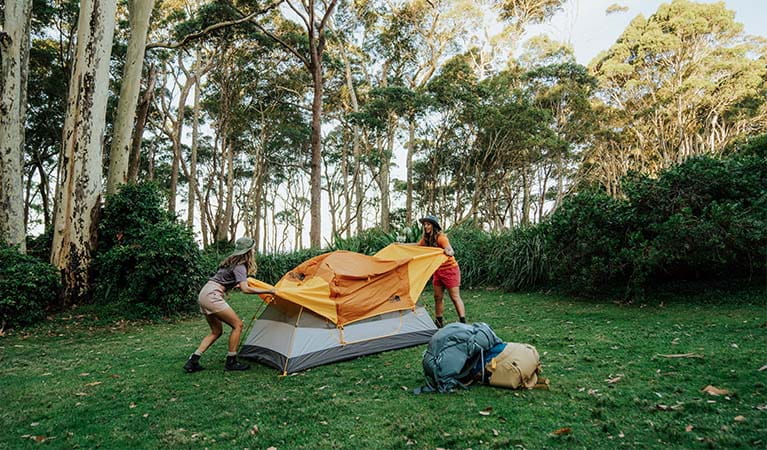Depot Beach campground
Murramarang National Park
Overview
Depot Beach campground in Murramarang National Park is right by the beach and perfect for a family camping holiday. Spend your days swimming, snorkelling, and fishing.
| Number of campsites | 59 |
|---|---|
| Camping type | Tent, Camper trailer site, Caravan site, Camping beside my vehicle |
| Where | 2B Depot Beach Road, Depot Beach, NSW, 2536 - in Murramarang National Park |
| Facilities | Picnic tables, barbecue facilities, carpark, public phone, showers, toilets, electric power |
| What to bring | Drinking water, food supplies |
| Entry fees |
Park entry fees are not included in your camping fees. |
| Group bookings | Bookings for up to 9 sites and 40 people can be made online. School groups and commercial tour operators can submit a group booking enquiry form. |
| Please note |
|
Set amongst the beautiful spotted gums native to the area, the location is perfectly idyllic for a weekend away. Once you’ve set up your tent, swag, camper trailer or caravan you’ll never want to leave.
The beach is just a couple of minutes' walk away and is the perfect spot to go for a swim, a snorkel, or relax with a book on the golden sand. There are great spots for fishing, and if you’re lucky, you’ll catch a glimpse of the local dolphins that seem to love this part of the coastline too. Once you’ve had enough of the sun and sand, both Rock Platform walk - Depot Beach and Depot Beach Rainforest walk leave from this area.
After a day of beach-dwelling, you can relax at your campsite, watching kangaroos graze on the surrounding grass and enjoying a tasty camp dinner as the night sky come alive with stars. You’re bound to feel a million miles from home.
Take a virtual tour of Depot Beach campground captured with Google Street View Trekker.
Map
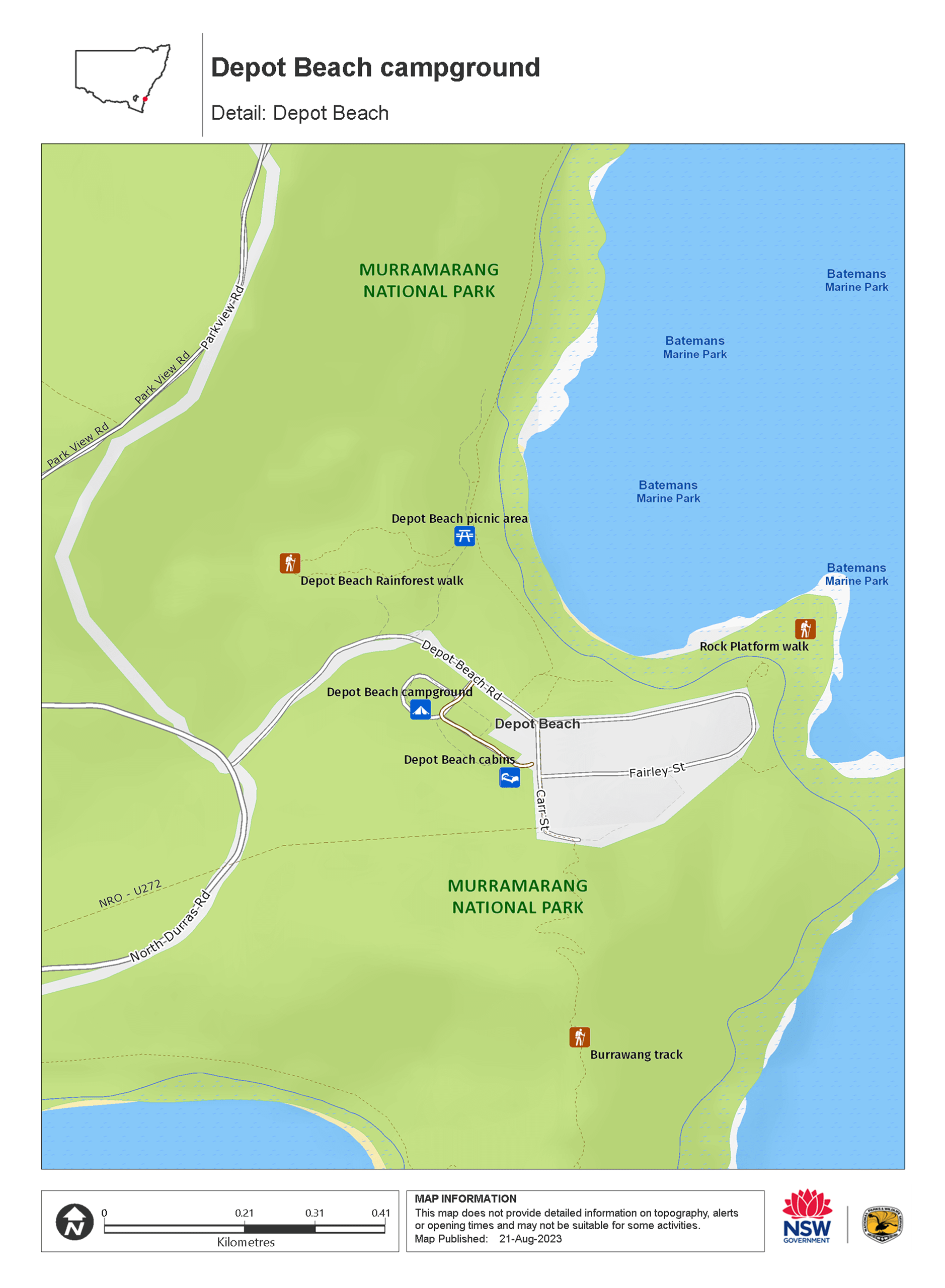
Map legend

Local alerts
For the latest updates on fires, closures and other alerts in this area, see https://www.nationalparks.nsw.gov.au/camping-and-accommodation/campgrounds/depot-beach-campground/local-alerts
Bookings
- National Parks Contact Centre
- 7am to 7pm daily
- 1300 072 757 (13000 PARKS) for the cost of a local call within Australia excluding mobiles
- parks.info@environment.nsw.gov.au
Operated by
- Depot Beach office
- Open daily, 9am to 4pm variable. Closed Christmas Day.
- 02 4478 6582
- depot.beach@environment.nsw.gov.au
- 2B Depot Beach Road, Depot Beach NSW 2536
Park info
- in Murramarang National Park in the South Coast region
Murramarang National Park is always open but may have to close at times due to poor weather or fire danger.
-
Park entry fees:
$8 per vehicle per day. The park has pay machines - cash and credit cards accepted. Card only at Pretty Beach.
Buy annual pass.
Visitor info
All the practical information you need to know about Depot Beach campground.
Getting there and parking
Get driving directions
Depot Beach campground is in the central precinct of Murramarang National Park. To get there:
- From the Princes Highway enter the national park via Mount Agony Road
- Take the right fork onto North Durras Road
- Then take Depot Beach Road to the campground
Road quality
- Sealed roads
Vehicle access
- 2WD vehicles
Weather restrictions
- All weather
Parking
- Parking is available on your campsite for 1 vehicle.
- Parking for tent-only sites is available on the perimeter of the tent-only camp area.
- Limited additional parking is available within Depot Beach campground carpark.
Best times to visit
There are lots of great things waiting for you in Murramarang National Park. Here are some of the highlights.
Spring
Spring is a great time to dust off your hiking boots and take to the park's tracks. Try the Pretty Beach to Durras Mountain walk for spectacular views of the coast and ranges.
Summer
There's no better time to head down the coast and catch some sunshine. With crystal clear waters for swimming and snorkelling, a beach camping trip is the ideal way to enjoy the Aussie summer.
Winter
Birdwatching opportunities abound at this time of year, see if you can catch the courting displays of lyrebirds in the park's rainforest areas.
Weather, temperature and rainfall
Summer temperature
Average
16°C and 25°C
Highest recorded
43.3°C
Winter temperature
Average
7°C and 16°C
Lowest recorded
0°C
Rainfall
Wettest month
March
Driest month
August
The area’s highest recorded rainfall in one day
275.3mm
Facilities
- Campsites are marked. Sites are suitable for caravans, camper trailers, campervans and tents.
- Water is available at this campground but it’s tank water so you’ll need to boil it before drinking.
- You can buy firewood, gas (swap-and-go) and ice at the campground office.
- Please place your rubbish in the bins provided.
Toilets
- Flush toilets
Picnic tables
Barbecue facilities
Shared covered picnic shelters with gas barbecues and a pizza oven. You can buy firewood at the campground office.
- Gas/electric barbecues (free)
- Fire rings
Carpark
Public phone
There's no mobile phone coverage at Depot Beach. There's an after hours phone with programmed numbers on the verandah of the Depot Beach office.
Showers
- Hot showers
Electric power
Powered and unpowered sites are available. Power is not available elsewhere in the campground.
Maps and downloads
Accessibility
Disability access level - medium
- Assistance may be required to access this area
- The campground has a wheelchair-accessible toilet and shower accessed via ramp
- The beach can be reached with assistance.
Permitted
Camp fires and solid fuel burners
Fires are permitted only in the fire rings provided. BYO firewood or purchase on-site. No fires may be lit on the ground.
Prohibited
Gathering firewood
Firewood may not be collected from the park.
Generators
Pets
Pets and domestic animals (other than certified assistance animals) are not permitted. Find out which regional parks allow dog walking and see the pets in parks policy for more information.
Smoking
NSW national parks are no smoking areas.
Learn more
Depot Beach campground is in Murramarang National Park. Here are just some of the reasons why this park is special:
Bird watching
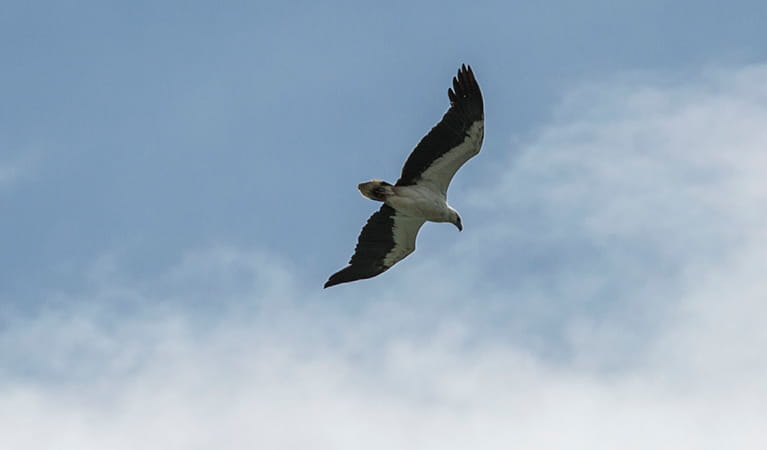
Birdwatchers are in for a treat; the park boasts more than 90 species of birdlife including three owl species, peregrine falcons, sea eagles, gannets, shearwaters, white-faced storm petrels, sooty oystercatchers, eastern yellow robins, satin bowerbirds, the rufous fantail and even a penguin colony. Look for the sea eagles and peregrine falcons soaring above the park’s cliffs and headlands and the rufous fantails and eastern yellow robins in rainforest gullies around Durras Mountain. You’re most likely to see sooty oystercatchers wading around the edges of lake areas.
Native animals
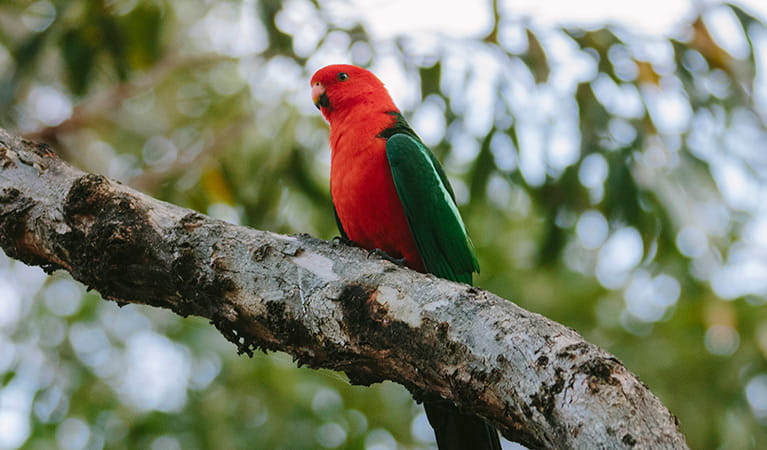
There’s an abundance of wildlife living in Murramarang National Park, but by far one of the highlights is seeing eastern grey kangaroos that spend their days dozing near the beaches and by campgrounds until dusk when they gather to feed. In the moist forests of the park you might see lyrebirds fossicking in leaf litter. Look for the stately, strutting wonga pigeon with its pastel blue-grey back feathers and black dotted stomach. If you don’t see it, you may well hear its repetitive, deep ‘whoop, whoop’ call that carries through the forest.
- Burrawang walking track Burrawang walking track, across Depot Beach Headland, features scenic coastal views, forests and birdwatching in Murramarang National Park, near Batemans Bay.
- Richmond Beach Richmond Beach is one of Murramarang’s hidden treasures. Just 50m from the carpark on an easy walking track you can enjoy picnicking, swimming, snorkelling, fishing and paddling.
Native vegetation
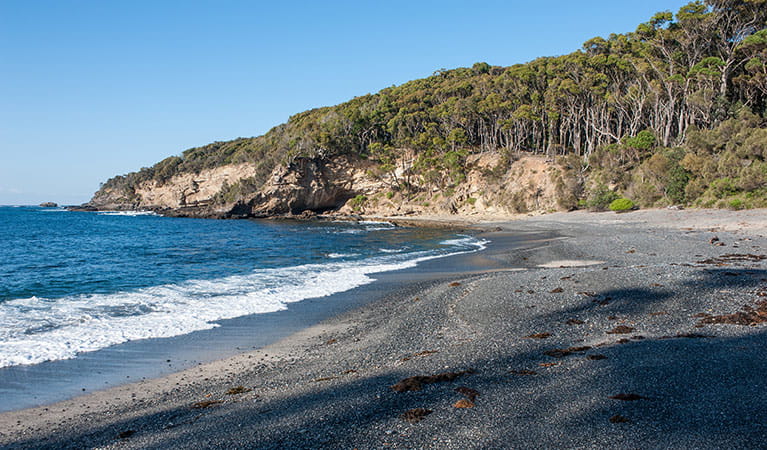
One of the really special things in Murramarang is the forest of majestic spotted gums; it’s one of the biggest continuous stands in NSW. With an understorey of burrawang palms, the forest stretches right down to the ocean and is truly a sight to see. You’ll easily recognise the spotted gums – they have a smooth, dimpled bark which is shed in summer to produce a mottled cream and grey ‘spotted’ appearance.
- Dark Beach walking track Dark Beach walking track leads to a secluded beach with unique rock formations in Murramarang National Park. Ideal for fishing, swimming and snorkelling.
- Depot Beach Rainforest walk Depot Beach marks the start and end of this easy walk through lush littoral rainforest. Go for a swim, surf, snorkel or paddle in the clear waters when you return.
- Rock Platform walk - Depot Beach Rock Platform walk near Depot Beach is a short walk to fascinating rockpools offering excellent birdwatching and scenic ocean views of the South Coast, just north of Batemans Bay.
Rich Aboriginal cultural heritage
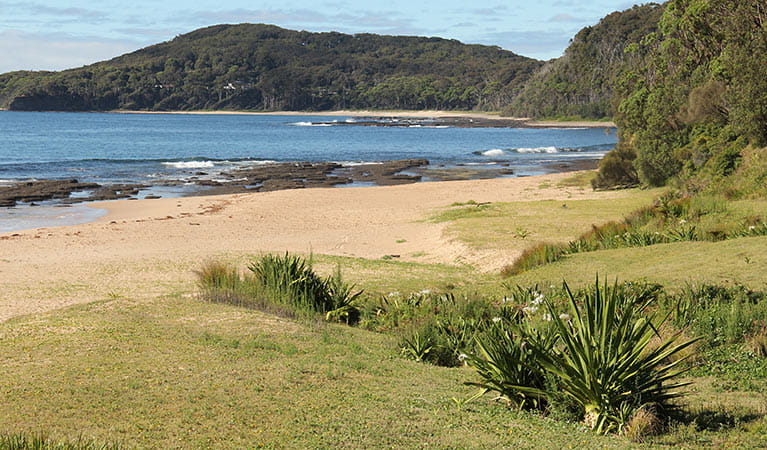
Aboriginal people have a long connection with the Country of Murramarang National Park, and this continues to the present day. The south coast headlands have long been a focus for economic life, giving easy access to the food resources of both the sea and the land, and plants within the park provided medicines and shelter. There is much evidence of the past today, including shell middens, tool manufacturing sites and indications of a specialised industry producing bone points and fishing hooks. Take a walk around Murramarang Aboriginal Area, near Bawley Point - there's a complex of middens that are of great cultural value.
- Then and now: Aboriginal culture Aboriginal culture then and now is a Stage 2 (Years 3-4) school excursion in Murramarang National Park, focusing on Geography and History. Through story and creative expression, the life and culture of the local people are shared.
- Then and now: Aboriginal culture Then and now: Aboriginal culture is a Stage 4 (Years 7-8) school excursion in Murramarang National Park, focused on History. Through story and creative expression, the life and culture of the local people are shared.
- Then and now: Aboriginal culture This excursion experience has been updated and is now being delivered in line with the new NSW Department of Education Curriculum. We will be revising this excursion's name and information online soon. Contact your local national parks office for more information about the updated excursion.
- Wasp Head walk This short walk leads to a spectacular view of Wasp Island and passes through historic Aboriginal sites of the area.
Plants and animals protected in this park
Animals
-
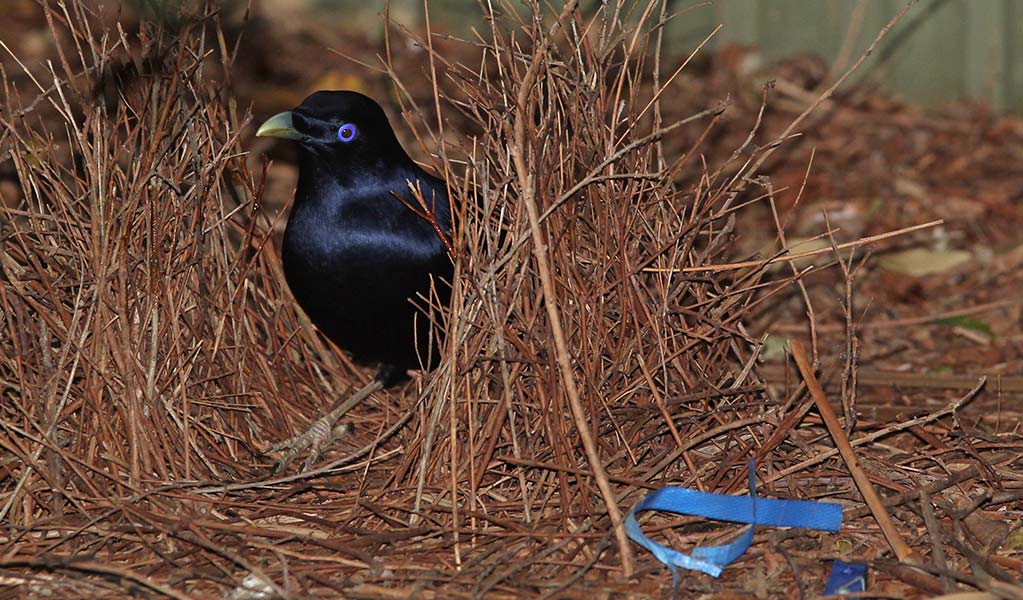
Satin bowerbird (Ptilonorhynchus violaceus)
With vibrant blue-violet eyes and curious antics, the satin bowerbird is a favourite for bird watching and easy to spot as it forages for food in open forest. Relatively common across eastern Australia, in NSW they’re found in coastal rainforests and adjacent woodlands and mountain ranges.
Plants
-
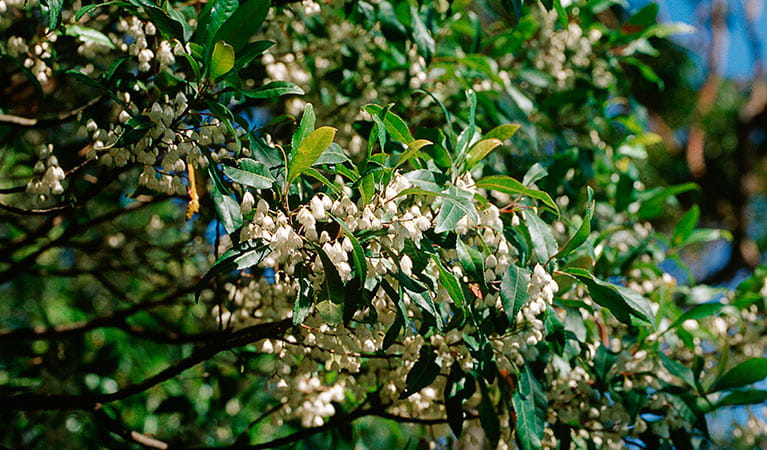
Blueberry ash (Elaeocarpus reticulatus)
The blueberry ash is a rainforest shrub which produces blue olive-shaped berries and spectacular bell-shaped flowers, which often appear on the plant together. It is a tall slender shrub or small tree found in rainforest, tall eucalypt forest and coastal bushland in eastern NSW, south-east Queensland and Victoria.
-
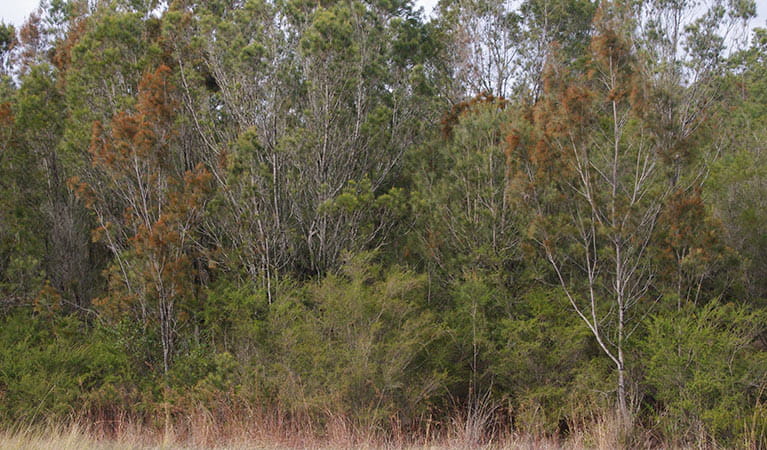
Black sheoak (Allocasuarina littoralis)
The black sheoak is one of a number of casuarina species found across the east coast of Australia and nearby tablelands. Growing to a height of 5-15m, these hardy Australian native plants can survive in poor or sandy soils. The barrel-shaped cone of the black sheoak grows to 10-30mm long.
-
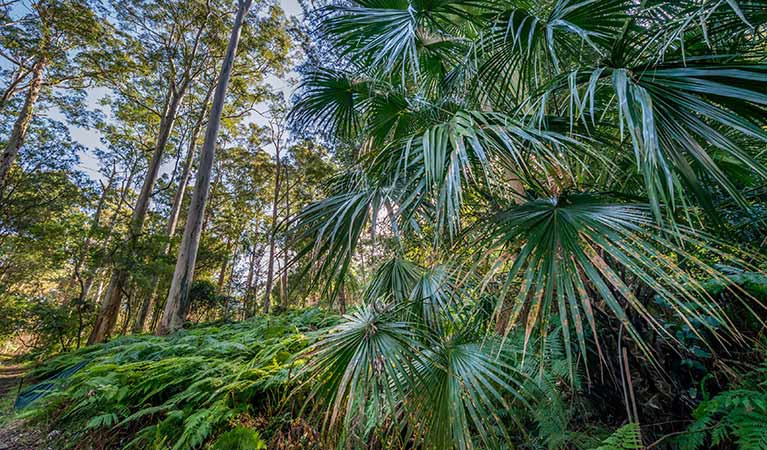
Cabbage palm (Livistona australis)
With glossy green leaves spanning 3-4m in length and a trunk reaching a height of up to 30m, the cabbage tree palm, or fan palm, is one of the tallest Australian native plants. Thriving in rainforest margins along the east coast of NSW, in summer this giant palm produces striking spikes of cream flowers which resemble cabbages.
-
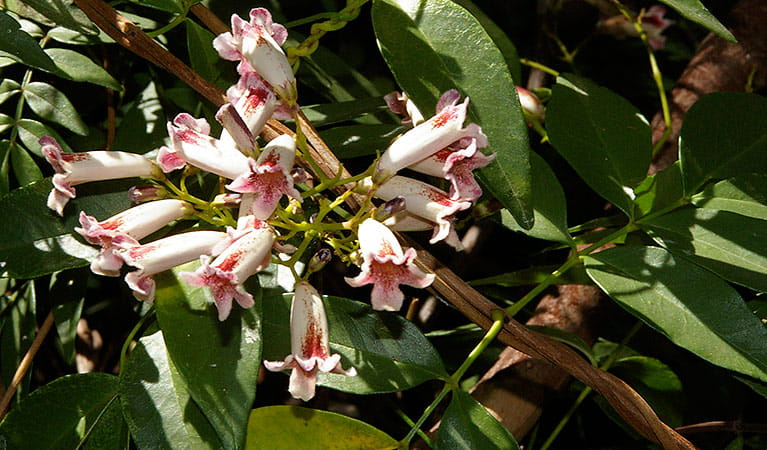
Wonga wonga vine (Pandorea pandorana)
The wonga wonga vine is a widespread vigorous climber usually found along eastern Australia. A variation of the plant occurs in the central desert, where it resembles a sprawling shrub. One of the more common Australian native plants, the wonga wonga vine produces bell-shaped white or yellow flowers in the spring, followed by a large oblong-shaped seed pod.

